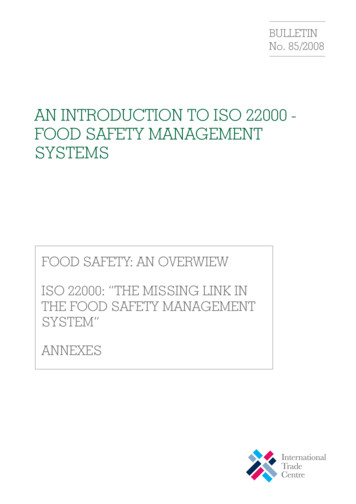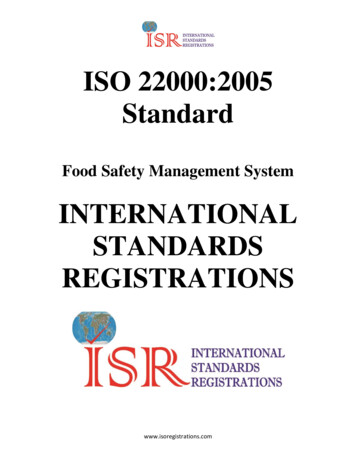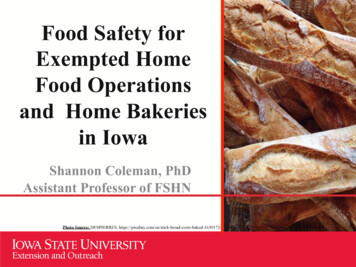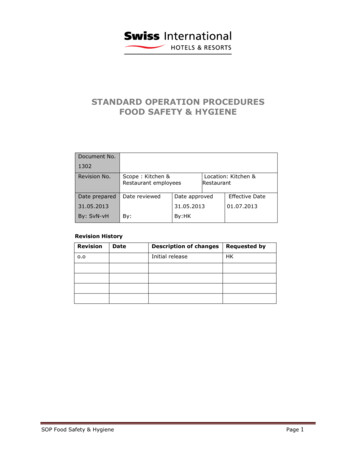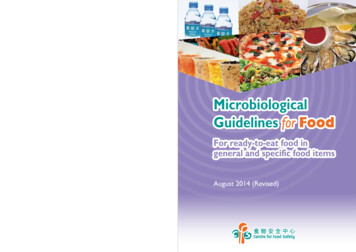
Transcription
12/23/2016Lecture ObjectivesIntroduction to Food Safety Lecture 2 Discuss the impact of changing food consumption on food safety. Describe food safety issues related to trends such as raw diets, organic foods,and local foods. Recognize the challenges related to a global food market. Explain the influence of health factors on food safety.Food Trends and Food SafetyChanges in Food Consumption A number of factors have resulted inchallenges for food safety including: Higher demand for raw produce.Higher demand for organic products.Higher demand for imported goods.Desire to use locally produced fooditems. Increased recognition of food allergies. Increased consumption of foodsoutside of the home.Consumption of Raw Produce The amount of raw produceconsumed in the United Stateshas been increasing for years. The FDA fully supports anincrease in consumption of fruitsand vegetables but does notendorse raw diets. Many of the pathogens in rawproduce are destroyed bycooking. Many recent recalls are due tocontaminated baggedlettuce/spinach.Raw Milk Recently there has beenincreased interest in consumptionof raw milk due to claims ofeverything from loss of calcium tothe dangerous side effects ofpasteurization. Neither of which is true. The FDA has launched a campaignto warn consumers of the risk ofraw milk following severaloutbreaks of dangerousorganisms including Listeria andE. coli 0157:H7.Is Raw Milk Worth the Risk? Several families have recordedvideos of severe illnesses thatoccurred due to consumption ofraw milk (available s ) Food safety experts do NOT supportthe consumption of raw milk andlegislation banning the sale of rawmilk is in place in many states(including Florida).1
12/23/2016Organic – What does it Mean? Organic foods are produced withoutantibiotics, hormones, pesticides,irradiation or bioengineering. Organic farmers are required toadhere to certain soil and waterconservation methods and to rulesabout the humane treatment ofanimals. Organic foods/farms are strictlyregulated by the USDA. Organic foods are now a billion dollarindustry.Organic Farming – Animal Manure Animal manure is commonly usedin both home and large scaleorganic farming. Chicken manure can potentiallyinclude dangerous pathogenssuch as Salmonella, E. coli, andListeria. Many have suggested that the useof animal manure in organicfarming poses a risk to theconsumer.Organic Foods – Safety Issues? Organic foods are not contaminatedwith trace amounts of pesticides andherbicides found in other foods. The lack of pesticide use and otherfarming practices may result in foodsthat are higher in bacterialcontamination. Controversial as other studies have shownthe opposite. Many products are on the market thatare labeled “organic” but do not meetthe USDA/FDA organic guidelines. The price of organic foods issignificantly higher.Foods that meet the required organicguidelines have labels such as the one above.Organic Farming – Animal Manure The FDA has proposed newguidelines concerning the use ofanimal manure. Data supports long term survivalof dangerous microorganisms insoil containing manure andtherefore the FDA is proposingrestrictions on use of manure infarming. Note: this is not law and thisproposal has met with strongopposition from the organic foodindustry.Lecture NoteImported Foods Organic foods are discussed here to illustrate that some food safety issues areunique to this type of agriculture. Food safety applies to both organic and conventional crops and outbreaksand illnesses have occurred due to both types of foods. One major concern with importedfoods is the unintentionalimportation of a food pathogennot present in the United States. For example, there are a numberof infections of fish that occur inAsia that we do not have in theU.S. The FSMA guidelines willostensibly make imported foodsmuch safer (discussed in Lecture19).Did you know that it isillegal to sell any foodproduct in the USwithout an Englishlanguage label?2
12/23/2016Imported Foods – Old PathogensHow Serious are “Old” Pathogens? A number of pathogens havebeen eliminated from the US foodsupply but still exist in othercountries including: Trichinella spiralis migrates tomuscle tissue once ingested. Can destroy any muscle, includingthe heart. Diagnosis is by punch biopsy inwhich a “chunk” of tissue isremoved for microscopy.Taenia saginata (beef tapeworm)Taenia solium (pork tapeworm)Trichinella spiralis (pork worm)Etc.Trichinella – histology from muscle biopsy. Previous slide shows larvae undermicroscope.How Serious are “Old” Pathogens (contd.)Imported Foods – New Pathogens Taenia solium is a pork tapeworm. When the larvae are consumed,they are relatively harmless. When the eggs are consumedthey migrate to the brain causinga disease known asneurocysticercosis. Frequently old pathogens acquirenew antibiotic resistance. Occasionally a previouslyunknown pathogen is detected: Mad Cow Disease The story of Mad Cow disease iscomplex and will be presented inmore detail in Lecture 9. Image shows brain destruction.Cow infected with BSE the agent that causes Mad CowDisease. -CNN.comNeurocysticercosis - Radiopaedia.orgHow Serious are “New” PathogensImported Pet Foods In 2007 14 pets died due to consumption offoods containing melamine. So far 226 (as of 2012) peoplelinked to the mad cow diseaseoutbreak in the UK have died. Not approved for use in foods. Likely added to falsely elevate protein content. Over 150 dog, cat, and ferret foods wererecalled. Including those persons pictured atright. The number of pets killed is unknown becausethere is no surveillance system in place forpets: Cases will likely continue toincrease as it can take years torecognize the disease. Likely thousands! Note: most pet foods are made by the samecompanies who make human foods. Lookclosely at your pet foods, do you recognizenames like Pedigree (owned by Mars) andPurina (owned by Nestle)?UK Daily News Source3
12/23/2016Global Food Distribution SystemsBrands Owned by ConAgra (2013) Many companies have globaldistribution systems: Common sources for foods Common distribution sites Multiple brands (see next slide) In other words, if a food (or aningredient) is contaminated at itssource or during processing, it couldpotentially spread worldwide.Seiyu Grocery in Japan. Look familiar? Thisgrocery chain is one of the largest in Japanand is owned by WalMart.Nestle – The World’s Largest Food CompanyNo matter where you are in the World, Nestle has an office!Coca ColaNestle BrandsThis viral internet photo suggest that Nestle may be making quite a lot of money on the many brands they own.As of early 2015, the brands shown are accurate but several are missing.Coca-Cola and ColaLife Coca-Cola has a worldwidedistribution system with thefollowing noteworthyinformation: Uses 5,000 ingredients 18,000 servings sold per SECOND! 1.7 Billion servings sold daily. How many people would beaffected before a problem isdetected?A condensed version of Coca-Cola’s brands. Note for exampleit doesn’t include all the available flavors of Fanta. On the other hand, the CocaCola distribution system can beused for health benefits. Where little medical help existsin places such as sub-SaharanAfrica, Coca-Cola is available. The ColaLife campaign usesCoca-Cola’s distribution systemto deliver treatments fordiarrhea and micronutrients. Torjesen, I. BMJ(2011);343;D58254
12/23/2016Locally Grown FoodsLocally Grown Foods The food industry has a significantimpact on the environment as aresult of transport of foods overlong distances: Some (but not all) locallyproduced foods create anumber of food safetyconcerns including: Non-approved sources Unknown handlingconditions Trucks Rail Ships This and the desire to support localeconomies has resulted in anincreased interest in locallyproduced foods.Picture from a Farmer’s market which claimed to sell only“local produce”. Do you think you can grow this manyproducts in the same environment? Sadly, some of thesemarkets resell foods purchased at grocery stores.Locally Grown Foods Cook infected with MRSA,Hepatitis A, Salmonella? Unknown growthconditions Recently articles advocating theuse of poultry droppings (knownto contain Campylobacter,Salmonella, etc) for compostwere released for homegardeners. Intentionally contaminatedExample of Potential Issue with Local Foods Locally grown and sold foodsfrequently “fly under the radar”of the FDA/USDA/EPA andtherefore do not conform to foodsafety regulations including: In 2009 blooms of red tide (algae)caused high levels of toxin tooccur in some shellfish in the Gulfof Mexico. Discussed in Lecture 11 FDA Food Code HACCP FSMA Potentially and quite possibly,these agencies may restrict thesale of locally grown foodswithout compliance to acceptedfood safety standards. Time/temp violations? Cross contamination? Personal hygiene issues? Homemade items What would happen if localharvesters were unaware of thepotential risks?Many “local” producers have been found to purchasesupermarket foods and re-label them “organic, local,free-range, etc”. These foods are considered mislabeledunder FDA guidelines and they could restrict their sale.Lecture Note! Locally grown foods are included here to illustrate how such foods createunique food safety issues. Studies have not demonstrated that locally grown foods result in more or lessfoodborne illness and this should not be taken as reason to avoid such foods. Note: The term locally grown is not recognized or regulated by any foodagency. The next time you see a food labeled “locally grown” check the labeland see if this is actually true.Increases in Food Allergies As allergy testing proceduresimprove and media sources reporton food allergies, the number ofpersons claiming food allergycontinues to increase. Currently, failure to label a knownallergen is the leading cause of foodrecalls. This has led to some changes in foodlabeling and increased awareness ofproduct labels. Discussed in detail in Lecture 11.5
12/23/2016Ingredients LabelFood Allergy Recalls How many items can you find onthis label that may be hazardousto a consumer’s health?Increased Consumption of Foods Outside of the Home The majority of foodborneillnesses are associated with foodconsumed outside of the home. Large scale food preparations maybe more vulnerable tocontamination. Consumers may report food eatenoutside of home as cause of illnessmore than food consumed athome. Food allergies as we will seein other lectures can bedeadly. Allergens were the leadingcause of recall on this FDAfood recall list.Health Issues and Food Safety The health of certain populationscan increase their risk for foodrelated illness: Aging populationImmunodeficient individualsMalnutritionLower quality foodsStaple foods such asthose seen above havepoor nutrient value. Illnesses are usually (and oftenwrongly) attributed to the last foodconsumed.Aging Population The over 65 year old populationof the United States continues toincrease and there are associatedfood risks: Decreased resistance to pathogens. Decreased sense of smell and tastefail to alert to spoiled foods. Increased reliance on delivery orfast foods. Co-morbidities and the medicationsused to treat these conditions(especially heart disease, diabetes).Immunodeficient Individuals Immunodeficient persons are morelikely to contract serious disease oreven die from pathogens found infoods. Recommendations include avoidingunwashed fruits and veggies,unpasteurized cheeses, and rawseafood.6
12/23/2016Public Health Implications of Rising FoodPrices – Low Income CountriesRising Food Prices Worldwide food prices are risingand diets are changing: Countries that rely heavily onimports such as Africa arevulnerable to food insecuritywhen costs rise. People living in growing economieshave shifted from traditional plantbased staple foods (rice, etc.) tomore expensive meat and dairyproducts. Brazil, Russia, India, China Meat and dairy products have foodsafety issues that differ from otherfoods (different pathogens, etc).Poorer quality dietsIncreased rates of malnutritionMicronutrient deficienciesAll of the above increase thesusceptibility to foodborneillnesses. Lock, K. et al (2009) BMJ; 339:pg269-72.Public Health Implications of Rising FoodPrices – Middle to High Income Countries Price inflation leads to consumersspending less on foods: Buying cheaper, poorer qualityfoods. Buying energy rich, nutrient poorfoods. Increases costs of healthyingredients: School lunch budgets must increasefor meals to remain nutritious. Welfare food vouchers decrease invalue (cannot be used for “junk”foods).This image is from Hillsborough Country WICprogram. It is a welfare voucher for fruit andveggies. Please note the amount is 6. How far doyou think 6 will go for produce versus fast food?Consumer Behaviors Contributing toFoodborne Illness. Consumption of raw eggs is mostcommon as it includes rawcookie dough, sunny-side upeggs, ceasar salad dressing, etc. Are you guilty of any of the “badhabits”?Malnutrition in Africa – World Health Organization.Food Handling Hygiene In response to the large numberof non-English speaking foodhandlers in the state, Florida hasrelease a number of food safetyposters, presentations, andguidelines in several languages. National safety training materialsare available in dozens oflanguages.Lecture 2 Conclusions Trends in food consumption can result in new food safety challenges. The general guidelines for producing safe food require frequent updates inresponse to consumer demand for foods. Regulatory agencies do respond and react to changes in food consumption.7
Introduction to Food Safety - Lecture 2 Food Trends and Food Safety Lecture Objectives Discuss the impact of changing food consumption on food safety. Describe food safety issues related to trends such as raw diets, organic foods, and local foods. Recognize the cha
